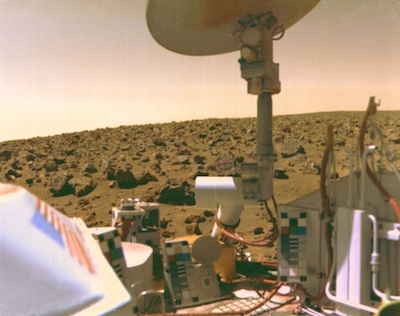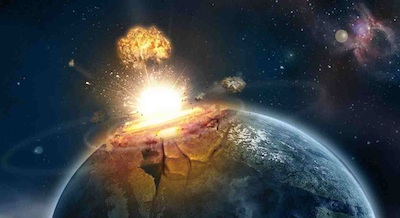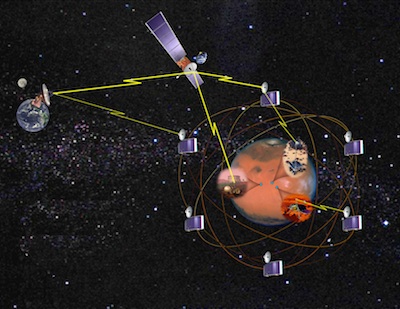 Welcome to Science Saturday! Tantalize your neurons this week with life on Mars discovered in 1976, how dino destruction sent Earth-life into space, auroras on Uranus (no, this is not a euphemism), and early subspace communication technology. All this and more, plus our gadget of the week: augmented reality contact lenses!
Welcome to Science Saturday! Tantalize your neurons this week with life on Mars discovered in 1976, how dino destruction sent Earth-life into space, auroras on Uranus (no, this is not a euphemism), and early subspace communication technology. All this and more, plus our gadget of the week: augmented reality contact lenses!
Mars Viking Mission May Have Found Life in 1976
The Mars Viking mission, designed to determine whether or not bacterial life exists on the Red Planet back in 1976, sent back data that scientists say shows no evidence for the existence of life — until now. Researchers have taken a second look at the data and say that there is in fact evidence for microbes crawling around on Mars. According to the study, published in the International Journal of Aeronautical and Space Sciences, in which Viking results were analyzed purely mathematically, the processes that occurred during the experiment are too complex to represent simple geological ones and therefor must be biological in origin.
“On the basis of what we’ve done so far, I’d say I’m 99 percent sure there’s life there,” biologist Joseph Miller told Discovery News. Other scientists are quick to point out that the methods employed by this controversial study are not well calibrated for differentiating between biological and non-biological processes here on Earth, and more needs to be done to determine whether these new claims are well founded.

An image taken by the Viking lander in 1976
That Dinosaur-Killing Asteroid May Have Sent Life Out into The Solar System (and Beyond)
Some 65 million years ago, a 10-km diameter asteroid smashed into Earth, creating tsunamis, major changes in climate, and, oh yeah, the extinction of much of the land-based life on Earth (including the mighty dinosaur). Now, scientists say that this impact may have also ejected life-bearing rocks into space — seeding the solar system and even nearby exoplanets with the ingredients for life. Many of these bio-rocks would have smashed into the moons of Jupiter, the scientists say, since Jupiter itself would pull in so many of the asteroids due to its massive gravitational pull. So, if we do find life on Europa or a nearby exoplanet, will we find life that originated right here on Earth?
Read more at MIT’s Technology Review, and read the scientific journal article.

Giant asteroid ended some life on Earth, may have seeded Earth-life in space
Hubble Gets First Ever Glimpse of Auroras on Uranus
In a stroke of photographic luck, scientists pointing the Hubble Space Telescope towards our distance planetary neighbor Uranus managed to take snapshots of aurorae lighting up the atmosphere of the icy gas giant. Auroras on Uranus have been measured before by passing spacecraft, but they’ve never been imaged. From the new images, scientists know that the flashes of light only last minutes, unlike the hours-long light shows that occur here on Earth).
Read the scientific journal article.

Aurorae on Uranus imaged by Hubble
Send a Subspace Message to Starfleet: Developing Tech for Communicating, Networking, Sending e-mail in Space
Optimistically, human exploration of space will be growing and booming in the coming decades, and those spacefaring people will need a way to send and receive information between spacecraft, ground stations, and of course Earth. Researchers at ESA are investigating ways to create an interplanetary internet of sorts using networks of satellites and satellite relay stations, for when that subspace message absolutely, positively has to be there overnight.
Read more at Science Daily.

NASA & ESA already use satellite networks to send data to and from Mars
Gadget of the Week: Geordi LaForge-Approved Contact Lenses
Darpa has teamed up with Innovega to design prototype contact lenses made to work with compact heads up display (HUD) units, according to BBC. The tech could allow soldiers to get an unprecedented view of a battlefield by allowing the lens-wearer to focus on two things at once: the world around them as well as the HUD device displaying all kinds of information. Innovega says the lenses could easily be used with sunglasses-style HUDs with built in projectors.

HUD-compatible contact lenses — would Geordi approve?
Science Bytes
Not enough science for you? Here’s a warp-speed look at some more science tid-bits that are worth a peek.
- The world’s most isolated cave is home to 4 million years old superbug
- Emperor penguin numbers double previous estimates thanks to new satellite images of Antarctica

Life on Mars?
I wish I could say I were convinced, but the data from Viking was inconclusive for over 30 years and now suddenly it’s being called a positive result? I’m not sold (but of course, I’m also open to the possibility).
I remember a similar ‘life on Mars’ mini-phenomenon with the Alan Hills Antarctic meteorite (ALH 84001) press conference in 1996; it had what looked like fossilized micro-bacterium on it’s interior surfaces. Both results are tantalizing; but not 100% conclusive. It’s as if Mars itself was begging us to take a closer look….
Let’s see what happens when the new MSL rover gets there. Maybe it’ll find yet another intriguing clue to the mystery of Martian life.
;-)
Those contact lenses are fascinating…but less Geordi LaForge-like and more like the Dominion viewscreen headsets from DS9.
Auroras on my…!?! (sorry, but someone was bound to say it.)
What I don’t get about this new Life on Mars theory is not the concept of re-examining the Viking data mathematically, but why none of the subsequent, more technologically advanced Mars probes wouldn’t have found evidence of life. I mean, wouldn’t it make more sense to mathematically re-examine the most recent probe’s findings rather than those of 30 years ago?
Sebastian and Cygnus X1… The principal investigator for the Viking instrument that detected life in 1976 has been adamant all along that his test was positive. The problem is that his was one of three Viking tests for life, and the other two came back negative, so the consensus then was that Viking found no life on Mars.
Since then, results obtained by Mars Pathfinder, Spirit/Opportunity, and Phoenix have cast the other two Viking results more and more in doubt. Assumptions made by the other two Viking tests are now known to be dubious at best. But none of the more “technologically advanced” probes since Viking have actually looked for life (because Viking already did and the verdict was ‘no’). Even the new Curiosity (if it lands safely, which I wouldn’t bet on) isn’t looking for life, but it should answer once and for all whether life could survive on Mars.
The best chance for actually proving life on Mars is the Mars Sample Return Mission once planned for late this decade of early next, but now on indefinite hold due to budget cuts.
# 3, 4.
Yes, but sadly none of the subsequent vehicles to land on Mars (the three rovers or Phoenix lander) carried direct life experiments, either. They were more concerned with latent water in the rocks and soil (which is one of the ‘prime ingredients’ for carbon based life).
And yes, a mathematical result (while intriguing) is still no more conclusive than a political exit poll. It’s almost like asking a binary computer to define happiness or something. But the burning question of life still remains ambiguous and (IMO) begs to be answered someday.
Maybe the MSL rover (which as Thorny correctly points out, will also have more of a geological rather than a biological focus) will shed more light or offer a few more clues to this intriguing issue…
Still think the question will only be conclusively answered with either :
(a) A future (non-budget cut) sample return mission
(b). Human beings (preferably international scientists) landing on Mars itself!
I probably won’t live to see the latter choice, but maybe I might live to see the first one.
I don’t think life exists on Mars. It may have at one point, but even that is doubtful. The only way to find out would be to do some excavating on the surface, which right now, is unlikely to happen. It’s been pretty much proven that life does not currently exist on Mars. They haven’t found one bacteria, or microbe.
As for the idea of the dinosaur-killing asteroid impact sending up rocks loaded with microscopic life-forms which then possibly landed on Mars, or the moons of Jupiter or Saturn, I think that’s very remote, if not impossible. The explosion of the asteroid impact was too small to send enough debris into space, and no bacteria on Earth has been found to be able to survive in space. Even if there was, the tremendous distances and the asteroid belt would be a big hurdle. It took a billion years for life to begin on Earth, and it would’ve taken millions of years for rocks from Earth to reach Europa, assuming they didn’t land on some other hostile moon or asteroid first. Millions of years more would have been required just for any bacteria to thrive on a moon with little sunlight, and with extreme cold that is a lot colder than Antarctica. Water inside any of the rocks would have been vaporized in the explosion.
Plus the majority of the rocks ejected in the explosion ended up being incinerated, or fell back to Earth.
Isn’t “international scientist” relative to their point of origin? If they are qualified, why does it matter what country they are from…..
6… Actually, Earth bacteria has already been found to have survived in space. Bacteria was found still alive inside the camera on Surveyor 3, which landed on the moon in 1967 and was returned to Earth by Apollo 12 in 1969.
Auroras on my WHAT?!? ( :-0)
Auroras on my WHAT?!? :-o
Double posts. Oh My!!!
Not yours crazydaystrom…not yours….
:)
Suh-weet ; I’m on the news.
Yes, people, it’s all about me, today…
Open your minds people, not only is there life on mars but theres evidence to suggest advance civ once lived on mars. I wish humans wasnt so closed minded and that the govts would tell you the truth.
@13 I know, we just saw all about it in that major movie last month.
Life on Mars?
It might only be a particle of preanimate matter…
Then again… it might not.
We are the Martians.
The planet is URR-uh-nuhss. It’s from Greek Ouranos.
.
Only silly people pronounce it like the element uranium (yuhr-AY-nee-umm).
Maybe Edgar Rice Burroughs was right about Barsoom (mars.)
# 15 Vultan
“There can’t be so much as a microbe or the show’s off…” ;-D
I think life on Mars is a possibility (not Barsoom’s Tharks or Helium inhabitants) but microbial is a possibility. I’m just not certain that either the inconclusive Viking data or the ALH meteorite are strong conclusive proof one way or another. It’s a fascinating mystery for humans (hopefully) to probe for ourselves someday, but I don’t we’ve answered the question conclusively with the Viking data….
And # 13 somethoughts–
It’s not that I (for one) wouldn’t want to believe in martians, but so called ‘proof’ like the ‘face’ or ‘pyramids’ (largely tricks of played played across natural formations) are simply not compelling evidence. Now if we found a martian corpse or honed metal (that wasn’t accounted for by the flotilla of Russian/US spacecraft that have bombarded the planet since the 1960s)? Then I might be compelled to believe that there were a past civilization. My cousin works for NASA at JPL; trust me, there is no conspiracy. The scientists at Caltech would be the FIRST people to break open the bubbly if and when life were discovered on Mars (even microbes). But as yet, the evidence simply isn’t there…
As Carl Sagan said (about observations of Mars from telescopes), “Where we have strong emotions, we are likely to fool ourselves…”
Forgive my ‘brain farts’;
In the above paragraphs (post #19) I meant to add the words “believe” in between the last sentence of the first full paragraph (between ‘don’t’ and ‘we’ve’).
And I typed the word ‘played’ twice in the 2nd.
Forgive the incoherency; I attribute it early onset senility, folks…. ;-)
Seriously folks, I would bet that we will eventually discover signs that microbial life once existed on Mars. But I doubt it is still around today.
#19
“Does it have to be completely lifeless?”
Speaking of Wrath of Khan, have scientists done any serious research of how we would go about terraforming Mars? Though, I guess the first problem is figuring out how to actually get there!
Anyway, I think by developing tech to clean up Earth’s atmosphere we could maybe also apply it to the Martian atmosphere… eventually.
22.
“Don’t tell me you’ve found something?” ;-)
I’ve gone to Planetary Society discussions (I’ve been a member almost 20 years now) about this very thing, and I’ve read Bob Zubrin’s idea of building giant greenhouse gas factories on Mars to thicken it’s CO2 atmosphere. The atmosphere would still be toxic, but warm and thick enough (after a matter of decades) to work in without full pressure suits (just O2 masks/tanks); and the thicker CO2 could be somewhat easily converted down to O2.
Also, there’s the idea of diverting water rich chunks of comets to the planet (I think even ENT used that one in a season 4 episode), or even genetically engineering plants to seed across the planet and attract sunlight and spark photosynthesis, etc. There are many theories; all of them (even the most ambitious) would take centuries. Sadly, there’s no Genesis device on the immediate horizon. I guess the bar alien in ST3 was right; “Genesis allowed is not”…. ;-)
However, I think if we DO discover any life there (even microbes)? We have to leave them alone. As Carl Sagan says, “If Mars is found to be inhabited (even by microbes)? Then the planet belongs to the Martians.”
Give them their own chance to evolve independently of us or our interference.
I know it seems ludicrous to essentially quarantine a planet for the sake of bacteria (we destroy trillions of terrestrial bacteria every day), but then again; we once began in earth’s oceans millions of years ago as simple, one-celled organisms. What would’ve happened if a superior form of life landed on Earth a billion or more years ago and decided we (in our very earliest stages of evolution) weren’t worth a quarantine?
Something to think about….
@23 Except that Mar’s seas dried up 2 billion years ago, and the future for any evolution of life from any current microbes would be extremely bleak. No air, no potential future of liquid water, and a planetary core who’s heat is dying down…no, any microbes there now are never going to amount to anything. Mar’s had its chance, and that period is long over with.
So if we do find a few microbes, after completing the science on then, I say bring in the trailer park trash and strip malls. :-)
#13.
Care to provide evidence?
Anyway, while there is only circumstantial (at best) evidence that bacteria and microbes inhabited the red planet, what we do know is that there is ice at the polar regions and that there were rivers and even lakes millions of years ago. The problem with Mars is, the atmosphere is too thin, and there is no volcanic activity which is needed to bring up valuable life-sustaining minerals from the interior. That is why civilization wouldn’t be possible without a bubble to create a sustainable environment made up of an Earth atmosphere and to protect people against solar radiation that easily penetrates the ozone layer-less atmosphere.
I agree with those that suggest we should build a base on Mars. I think we could learn even more about our own planet’s beginnings and also study the Red Planet much more closely and efficiently than what we are able to do now from Earth. I don’t see the whole planet being colonized though. I don’t think there’s enough natural resources there to sustain a billion people. I could see several cities of a thousand or so people in bubble environments making a go of it.
The Phoenix lander found subsurface water ice (even took photos of white water ice right before it sublimated into vapor in the thin Martian atmosphere). And orbital surveys have shown that water ice exists in great quantities at the northern pole. Atmospheric density is also far greater in places such as the bottom of Valles Marineris or the Hellas crater basin. There are also large concentrations of methane built up in certain locales on Mars (a lot more than can be accounted for on a near geologically dead planet). Martian ‘farts’ possibly … ;-)
There are lots of ‘hiding places’ for life (life is far more tenacious than we thought in previous decades; as expeditions to the North pole and deep seas of our own planet have proven). Life adapts to it’s environment in spite of itself… we’ve seen that much too often on our own world.
I’m not saying that this all adds up to conclusive evidence for life, but IMO it’d be many decades before Mars is so thoroughly explored to be declared alive or dead in a single breath.
And if we find microbes? Who are we to take their world away from them? They would be as we once were; and we shouldn’t play god with an alien biosphere (if we do indeed discover biology there). Study it and let it be. Let’s not repeat Earth’s mistakes all over again.
Only if Mars is conclusively proven to be 100% lifeless (which it very well may be)? Only then IMO would we have the right to use it for ourselves.
Just my opinion, of course…
#23–26
Thanks for the info, guys. Interesting discussion to say the least.
Whether there’s life there or not, I think we should go to Mars—plain and simple. Let’s see what’s there with our own eyes. And after that… who knows? The moons of Jupiter and Saturn look interesting…
By the way, on the subject of Saturn’s moons (specifically Titan), anyone else seen the movie “Gattaca”? I just watched it the other night and was blown away by it. Okay, it’s not quite as brilliant as “Blade Runner”, I think, but still deserves to be more well known.
Oh, and on the subject of genetic engineering and space travel, check out this comic series called “Spaceman.” I haven’t read any of the issues, but the concept sounds like something we could see in the future.
http://en.wikipedia.org/wiki/Spaceman_%28comics%29
Most of the work I have seen on terraforming mars pretty much straight-lines current technologies into building huge greenhouse plants on mars, combined with bio-engineered plants that can function on Mars, and then you have to wait hundreds of years for the atmosphere to develop.
If you look at advancements in nanotechnology and artificial intelligence, and let’s say those technologies advance significantly in 100 years from now, then you might see micro atmosphere processors in the form of “self-replicating machines” being introduced into Mars’s surface and atmosphere, where through continual self replication (based on materials available on Mar’s surface), you might see a cascading/chain reaction such that in a few decade you would end up with an atmosphere suited to human habitation.
#25
I wouldnt just make it up :) there are 2 versions of truth and knowledge, public and need to know basis :) didnt you peeps watch transformers? So many movies and tv sci fi influenced by these types of black ops knowledge.
The worlds secrets has been always shown in form of entertainment :)
Just don’t know about life playing billiards in the planets. Doesn’t that just take a phenomenal longshot (life itself) and multiply the odds immensely (shooting a bullet in any direction and actually hitting sizeable matter, much less a body with enough of a biosphere to nurture life)? I’m not the brainiac here… seriously… but, I kinda of lean towards theories that say life is much easier to propigate than we have believed up to now… that is, water, sunlight, complex matter… sumthin’s gonna happen.
Martians from 1976? Did they wear red, three-piece liesure suits??
Never sure heads-up displays are a good idea. Hell, we can’t keep people from texting and driving. I think that stuff would be fine for one or two designated soldiers, but not the whole platoon.
Anyway… Thanks, Kayla.
#27 Vultan
My wife and I LOVE “Gattaca.” Saw it when we were dating (and of course, we own the DVD). If you enjoyed that one, you might want to check out some of director Andrew Niccol’s other movies, including last year’s “In Time”, and 2005’s “Lord of War” (one of Nicholas Cage’s best, IMO).”
He is also the writer of “The Truman Show.”
“Gattaca” was an amazing movie. Like “Blade Runner”, it gets better and better the more you watch it….
Speaking of dinosaurs, here’s an interesting article…
“Welcome to our new lizard overlords: New study suggests alien worlds could be full of super-intelligent dinosaurs
Life-forms based on different amino acids could be intelligent dinosaurs
Mammals only triumphed on Earth due to ‘accident’ of asteroid
‘We would be better off not meeting them,’ says American scientist
Nasa’s Kepler telescope scans the skies for ‘habitable worlds’ – but an American chemist has suggested the whole project might be a terrible idea.
Ronald Breslow suggests that life-forms based on slightly different amino acids and sugars could take the form of huge, ferocious dinosaurs that have evolved to have human-like intelligence and technologies.
‘We would be better off not meeting them,’ says Breslow, who claims that it was a stroke of luck that an asteroid wiped out dinosaurs on earth, leaving the field clear for mammals such as humans.
On other worlds, dinosaurs could have evolved into huge, intelligent warriors armed with hi-tech weaponry – but without losing their hunger for fresh meat.
‘Of course,’ Breslow says, ‘Showing that it could have happened this way is not the same as showing that it did. An implication from this work is that elsewhere in the universe there could be life forms based on D-amino acids and L-sugars.
‘Such life forms could well be advanced versions of dinosaurs, if mammals did not have the good fortune to have the dinosaurs wiped out by an asteroidal collision, as on Earth.
‘We would be better off not meeting them.’
In the report, noted scientist Ronald Breslow, Ph.D., discusses the century-old mystery of why the building blocks of terrestrial amino acids (which make up proteins), sugars, and the genetic materials DNA and RNA exist mainly in one orientation or shape. There are two possible orientations, left and right, which mirror each other in the same way as hands. In order for life to arise, proteins, for instance, must contain only one chiral form of amino acids, left or right.
With the exception of a few bacteria, amino acids in all life on Earth have the left-handed orientation. Most sugars have a right-handed orientation. How did that so-called homochirality, the predominance of one chiral form, happen?
Breslow describes evidence supporting the idea that the unusual amino acids carried to a lifeless Earth by meteorites about 4 billion years ago set the pattern for normal amino acids with the L-geometry, the kind in terrestial proteins, and how those could lead to D-sugars of the kind in DNA.”
http://www.dailymail.co.uk/sciencetech/article-2128650/Welcome-new-lizard-overlords-New-study-suggests-alien-worlds-super-intelligent-dinosaurs.html
Sebastian S, re: #32:
““Gattaca” was an amazing movie. Like “Blade Runner”, it gets better and better the more you watch it….”
It sure does. Gattaca is beautifully picturised too. The whole visual style is very elegant, from the technology to the architecture to the fashion. It’s got that “early 1960s” vibe, obviously with a futuristic twist.
Speaking of stylish stuff, I saw you mentioned “Mad Men” a couple of days ago. I love that show too. In fact, you should also check out this article comparing Draper with Kirk and noting the parallels in 60s attitudes present in both Mad Men & TOS Star Trek…
“Why Don Draper is the Captain Kirk of Mad Men”: http://whatculture.com/tv/don-draper-the-captain-kirk-of-mad-men.php
#34 Jai
Brilliant article!! ;-D
Thanks. And yes, I definitely see a strong parallel between DD and JTK! Both screw around a lot, both have a strong marrow of fair play for others within them (despite their screwing around). And both are not necessarily the heads of their organizations (Kirk is only a captain, not head of Starfleet), but in many ways, they are the ‘face’ of their group (Kirk is ambassador to the Federation many times over).
Also read your post on intelligent dinosaurs. It is possible that reptiles are the ‘path of least resistance’ for the evolution of life (especially coming from the oceans), but I can’t help but wonder if extinction-level-event asteroid collisions are just as common in evolution? Maybe nature ‘wipes the slate clean’ on many life-filled planets every hundred million years or so? Perhaps clearing the stage for mammalian ‘uprisings’ on many such worlds. I also liked Breslow’s idea about L-geometry amino acids tipping the scales in favor of mammal evolution (possibly). Again, I can’t help but wonder if perhaps this is a common influence on life everywhere?
As Spock says, ‘there are always possibilities’…. ;-)
Also glad to see a little more love for “Gattaca” on this site!
It was one of my favorite movies of the last 20 years. I love the ‘retro-futuristic’ production design as well (and the clever use of Frank Lloyd Wright architecture; George Lucas used many of the same locations in “THX-1138”). The short-lived BSG spinoff “Caprica” was clearly influenced by “Gattaca” (though sadly, not as good as Gattaca, IMO).
Getting back to Mars? It’d be interesting if life is present on Mars (even if only microbes). It would literally DOUBLE the odds for life in the universe everywhere, according to Frank Drake’s equation! ;-)
Life ejected from Earth after the meteor strike? Now we know why they speak English at every world the Enterprise visits!
#24 Nah, Mars has had it. MJ said so- so there it is. Sorry little green fellas! :-p
What did they say the chances of anything coming from Mars were? I think it was quite a lot wasn’t it? I think it was a Million to one they said. But, well, still it came….. :-D
#32
Haven’t seen “In Time” yet, but I have seen Niccol’s other works.
His writing reminds me of Rod Serling in a lot of ways.
Good to see some Mad Men fans here, too. What do you guys think of season 5 so far? Seems to be taking a bit longer to find its direction this time around.
Love Gattaca. A little romancy, but, yeah, both visually and, well, everything else, one of my favourite genre movies. Heck, one of my favourite movies period.
In Time is good and has some good ideas underpinning it (ideas which don’t really get developed, but it is nice not to have “this is the message” thrown at in lengthy speeches, although there is some of that) and a nice anti-capitalism bent — it’s a lot more over the top crazy-actiony (and over the top visually, comparably — but it’s still not the standard movie near-future with flying trains and giant video-screens everywhere) than Gattaca..
You may not believe this but i just saw cabin in the Woods….best movie of the year
Loving the discussion in the comments this week.
4. Thorny – April 14, 2012
I understand your point, but it seems strange that NASA wouldn’t have built some redundancy into the missions subsequent to Viking. That they just gave up so easily on testing for life after the ambiguous results of the Viking tests is puzzling.
#42
Feel free to join in, Kayla. I mean, c’mon, it is your article. And the opinions of a REAL scientist can’t hurt the discussion.
Oh, and tell Neil Degrasse Tyson and Michio Kaku they’re welcome here, too. ;)
How about that Martian monolith?
“Dave… Dave… I’m afraid, Dave…”
Thanks, Kayla. I always enjoy your articles, even if I usually refrain from comment, for lack of anything to offer.
Oh, oh. Speaking of robots, DARPA has released video of this robot climbing stairs. Scary because the robot is very militaristic. Didn’t these guys watch Terminator?
http://www.huffingtonpost.com/2012/04/13/petman-robot-stairs-darpa_n_1423488.html
#47. BB
Or the new Battlestar Galactica? I could see it now:
“The Stairclimbers were created by man…
They evolved. They walk like humans. Some believe that they are human.
And they have a plan!”
People really shouldn’t have to suffer from this anymore. With all the fast acting creams and salves and such.
Sebastian S, re: #35:
Apparently Don Draper is basically supposed to be a younger, more ruthless version of Roger Thornhill, the iconic Madison Avenue ad exec played by Cary Grant in “North by Northwest”. During the first couple of seasons of “Mad Men”, Draper even wears exactly the same business attire as Thornhill.
Jon Hamm has stated in interviews that he’s deliberately trying to avoid getting typecast in 60s-style roles, but I think he’d be great as a Starfleet captain, either in the JJverse movies (the threequel ?) or in some spinoff TV show in a few years.
About dinosaurs and extinction level events…it’s obviously impossible to speculate with any accuracy until ET comes a-calling or mankind travels out there and checks everything out first-hand ;) The twist is that evolution doesn’t necessarily guarantee the development of intelligence equalling or surpassing the level possessed by humans, even if any given predatory species survives for tens of millions of years. There’s a fantastic book called “The Eerie Silence” by SETI’s Paul Davies which explains all this brilliantly. (The book is full of mindblowing ideas about technologically advanced alien civilisations; you should definitely check it out).
“Caprica” had a nice retro 50s style, at least for the male characters. The writers dropped the ball with the execution of the storyline, except for the gripping finale, which was outstanding (the whole show should’ve been like that right from the start). It’ll be interesting to see what they do with “Battlestar Galactica: Blood and Chrome”, if that show manages to see the light of day; according to Bear McCreary, the show is ready to go.